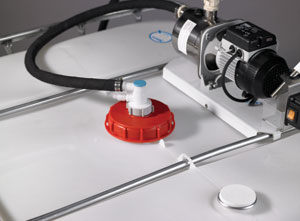haust fluid pump filter. This filter needs to be changed between 150,000 and 250,000 miles, depending on duty cycle. All of the other maintenance items, including diesel particulate filters, remain the same.”
As for oil change intervals, Williamson says they have not changed for 2010 Detroit Diesel engines. He adds, “They remain the longest in the industry at 50,000 miles for long-haul operation (greater than 6 MPG and more than 60,000) down to 25,000 for severe-duty (less than 5 MPG and less than 30,000 miles per year). Our customers have experienced great success with these industry-leading intervals in lowering cost of ownership and keeping their trucks on the road longer with no engine issues or oil degradation issues.”
In addition, Williamson points out that DEF is a non-hazardous material that is simple and convenient to use. The handling instructions are similar to that of diesel fuel. DEF is corrosive to aluminum and if spilled on aluminum should be cleaned up with soap and water. DEF’s shelf life should not be an issue unless stored in areas that see consistent temperatures above 80˚ F (the city with the highest average temperature in the U.S. is Key West, Fla., at 75-degrees F) for extended periods of time (months). Stored in more typical conditions found in North America, DEF has a shelf life of over a year (more in many cases). Most DEF distributors recommend buying amounts that will be consumed in a year or less from the purchase. Dispensing DEF is also similar to that of diesel fuel. In bulk, DEF is dispensed through a pump just as diesel fuel. In smaller containers (2.5- and 1-gal.), a nozzle is provided to ensure filling the DEF tank is safe and hassle-free.
Detroit Diesel has delivered over 3,500 EPA 2010 certified DD13, DD15 and DD16 engines to its customers and has another 10,000 engines in the back log. These 2010 certified engines have virtually no base engine changes from their EPA 2007 design with the majority of the changes coming in the form of the aftertreatment system and BlueTec emissions technology, Williamson adds.
Ed Saxman, Volvo Trucks North America drivetrain product manager, agrees, “There’s very little additional maintenance associated with our EPA10 solution. We’re using the same engines. And there are no recommended service intervals for the SCR catalyst. But it is very important to use only pure DEF meeting ISO-22241. The use of “homemade” DEF will clog the DPF—in a way that cannot be eliminated via regeneration.”
Saxman goes on to say that one of the reasons that Volvo employs its “No Regen” design is that without any of the high 1,100˚ F temperature cycles associated with “oxygen-based” regenerations, there is less chance for eventual cracking of the SCR catalyst substrate.
David McKenna, Mack director of powertrain sales and marketing, says, “The good news is that there is very little additional maintenance associated with Mack ClearTech SCR technology. There is nothing really “new” when it comes to the engine, since we’re continuing to use our proven, highly fuel efficient Mack MP series. The SCR catalyst is not a serviceable item—no moving parts contained within it and nothing to wear out.”
However, McKenna notes that the diesel exhaust fluid (DEF) filter should be changed at 6 months in service and every 12 months thereafter. The DEF injector should be inspected and cleaned every 6 months or so. “Be sure to use pure DEF and that’s it,” adds McKenna.
| DEF dispensing made easy |
|
Colder Products Co. has come up For safe and efficient delivery of DEF from bulk transfer containers, the DrumQuik Pro system is comprised of two components compatible with ISO 22241: a polypropylene coupler and a polyethylene drum insert assembly. The drum insert assembly contains a bung closure and dip-tube and can be shipped as part of the container package, safely sealing it from the point of fill to point of use. No special tools are required to connect the coupler to the system. A built-in vent port allows connection of a filter to protect the DEF from air exposure and prevent contamination. For more information, visit www.colder.com/def. |
2010 Engines: Another option
In response to new federal emission standards that went into effect Jan. 1, 2010, in the United States and Canada, engine manufacturers selected one of two choices to achieve a reduction in emissions of nitrogen oxides (NOx). They either provide an in-cylinder approach through increased exhaust gas recirculation (EGR), or an engine aftertreatment approach using selective catalytic reduction (SCR) technology, in combination with exhaust gas recirculation.
“The choices in engine technology available to truck and private fleet operators have never been so different,” said Olen Hunter, director of sales for PACCAR Leasing, (PacLease). “And making the right choice has never been so important for companies to control their fleet operating costs, get more mileage out of the engines and gain a competitive edge.”
Full-service leasing choice
New engine emission control standards offer one reason why companies should consider full-service leasing from a company that understands the new 2010 engines, Hunter said. PacLease, which has a strong relationship with engine manufacturers and close ties to truck manufacturers Kenworth and Peterbilt, can help companies make informed choices of trucks with 2010 engines.
“Leasing can help take the guesswork out of specifying and servicing 2010 engines,” Hunter said. “Plus, the leasing company can handle any warranty issues and take over any risk associated with truck resale values.”
SCR & OEMs
From an engine performance standpoint, because the SCR aftertreatment system handles the NOx reduction downstream from the engine, SCR allows manufacturers to develop engines that last longer and work more efficiently. Alan Treasure, director of marketing for PACCAR Engines, said PACCAR developed a 12.9-liter engine with a block and cylinder head manufactured with high-strength compacted graphite iron, (CGI), a premium material that’s 75% stronger and 20% lighter than conventional grey iron. The high-strength crankshaft with no counterweights also reduces the weight of the MX engine by 25 lbs. and increases power for quicker acceleration and smoother overall operation, he added.
Like PACCAR, Cummins also found SCR gave its engineers opportunities to improve the engine in many new ways, Wenzler said. The SCR aftertreatment system allowed engineers to make modifications that improved driveability, offered more responsive torque and created a quieter operation.
Lou Wenzler, on-highway communications director for Cummins Engine Co., says Cummins decided in August of 2008 to abandon plans to use the EGR-only approach. “By operating trucks with 2010 engines using SCR technology, fleets can still maintain fuel economy at lower or higher engine speeds. Plus, there’s no increase in EGR rates, which can cause excessive water condensation in the engine and sulfuric and nitric acid formation in the intake.”
Wenzler adds, “There’s no diminished life-to-overhaul. Service intervals remain the same on 2010 engines as they were before the new regulation took effect. The only change is the addition of new, but simple, DEF filter service intervals, usually about 200,000 miles depending on the engine manufacturer’s recommendations.”
“While full-service leasing offers benefits, including the ability to preserve lines of credit for core business projects or other revenue-generating endeavors, it can also help make choosing a truck with 2010 engine technology easier and more affordable,” Hunter said.
“If you’re considering acquiring trucks with 2010 engines for your fleet operation, consider your two choices in emission control, and know full-service leasing may offer the best way to go about it,” Hunter added.

 with a DEF dispensing solution for fleets, DrumQuik Pro, which is installed by the chemical packager and travels with the DEF container. Upon arrival at the station or filling site, the user can easily connect the rugged dispensing coupler. The easy-to-use, closed-system design combines into one integrated unit a recyclable bung closure and dip-tube with a reusable quick disconnect coupler, ensuring that both sides are sealed from point-of-origin to point-of-use.
with a DEF dispensing solution for fleets, DrumQuik Pro, which is installed by the chemical packager and travels with the DEF container. Upon arrival at the station or filling site, the user can easily connect the rugged dispensing coupler. The easy-to-use, closed-system design combines into one integrated unit a recyclable bung closure and dip-tube with a reusable quick disconnect coupler, ensuring that both sides are sealed from point-of-origin to point-of-use.


